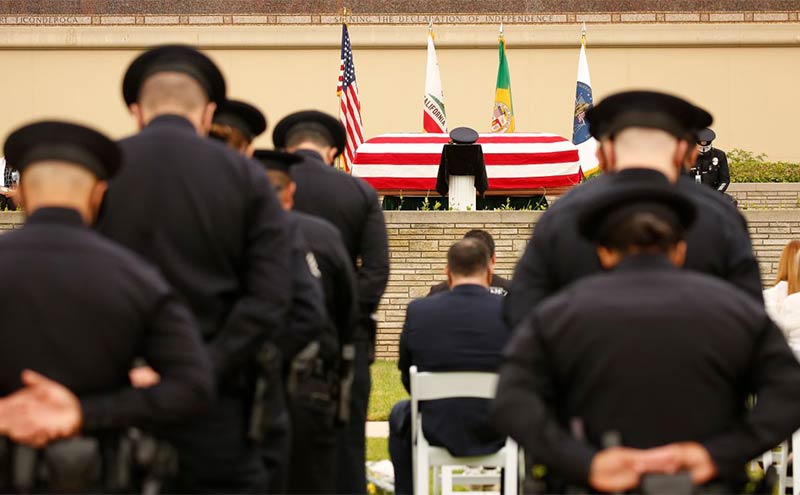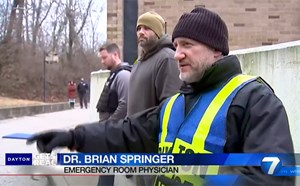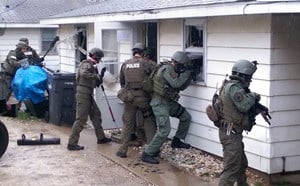
No More Preventable Law Enforcement Deaths
This article is an introduction to Law Enforcement Emergency Medicine: critical medical care for emergencies encountered by law enforcement as a result of and in the context of the unique nature of all law enforcement work. Tactical medicine addresses medical care for SWAT operations; however, most law enforcement emergencies occur during routine police work. With an investment of well-considered training and equipment, as introduced here, all officers can be better prepared to handle the emergency medical situations that result from their dangerous work. The goal of Law Enforcement Emergency Medicine is an end to preventable law enforcement deaths.
There is no doubt that law enforcement is a dangerous job,1 but what makes law enforcement work dangerous? Law enforcement work is dangerous because of the risk of injury, illness, harm or death. When you consider this definition, you realize, injury, illness, etc. are medical conditions and it is these medical consequences of law enforcement work that make the job dangerous. We know that many civilian acute medical illness and trauma deaths are preventable, and we can assume many law enforcement deaths are preventable as well.
What has been done to address the potentially preventable causes of death in law enforcement? Tactical medicine is a newer field of medicine in support of SWAT. While tactical medicine is a good start in medical support, SWAT activities are not how most officers spend their working day and SWAT operations are not the most common setting for critical medical emergencies. Indeed, over 95% of incidents resulting in law enforcement deaths occurred in non-tactical circumstances.2 Tactical medicine typically is practiced in a relatively defined space – the SWAT operations location. Often there are nearby LE support vehicles for extra equipment. Some agencies have dedicated medical personnel available for SWAT call-outs and EMS can be staged ahead of time near SWAT operations as well. But what about non-SWAT law enforcement activities?
To better address the "predictably unpredictable” dangers of daily law enforcement work, not just SWAT, I propose a new concept: Law Enforcement Emergency Medicine (LEEM). I define LEEM as: medical care for emergencies encountered by law enforcement as a result of and in the context of the unique nature of law enforcement work. LEEM includes tactical medicine but more completely addresses the spectrum of emergency medical care that is needed by all law enforcement for the dangers inherent in daily law enforcement work. Some law enforcement deaths are tragically unpreventable. The goal of LEEM is to eliminate preventable deaths in law enforcement.
Training time is short, budgets are tight and space to carry more gear is in limited supply for many law enforcement agencies. However, within the framework of LEEM, very simple and actionable steps can be taken to mitigate harm. Because LEEM is focused on and limited to addressing only the emergencies that will kill an officer before there is time to wait on EMS, or get to a hospital, training is manageable and not overwhelming. Officers can be equipped with minimal expense and minimal extra carry space on person or in vehicle. For reasons I will outline in this article, it is vitally important that law enforcement learn these skills and have this equipment. Emergency and tactical physicians are particularly suited to offer this medical training.
Why Does Law Enforcement Need Emergency Medical Skills When There is an Existing EMS System?
Traditionally in a medical emergency, law enforcement calls for EMS medical assistance, however many true medical emergencies cannot wait for EMS arrival. Law enforcement officers are regularly exposed to critically time sensitive injuries or illnesses that must be treated within minutes. Professional medical help is often not available in that time frame. Put those two facts together and we see this combination of officers’ serious injury or illness plus delay to medical care has, and will continue to, lead to preventable deaths. Law enforcement officers must be able to treat themselves or their partners in these situations.
Researchers found that the average time for an EMS unit to arrive on the scene from the time of a 911 call was seven minutes and increased to more than 14 minutes in rural settings. Nearly one in ten encounters wait up to half an hour for EMS personnel to arrive. Longer EMS response times are associated with worse outcomes in trauma patients and ambulance response time of over ten minutes appears to contribute to preventable deaths.5,6 When a massive hemorrhage, chest wound, sudden cardiac death or allergic reaction occurs, medical treatment is needed within minutes to be most effective.
Some emergencies require rapid access to a higher level of care. One of the more common potentially preventable deaths sustained by law enforcement, gunshot wounds to the chest, has increased survival rates with a “scoop and run” approach. Indeed, patients with penetrating chest wounds who were transported to the hospital by law enforcement or private vehicle with no medical treatment had shorter transport times and double the survival rates than those that arrived by EMS.7
EMS scene safety is another factor in EMS delay on scene to an injured or sick law enforcement officer. The current training of EMS stresses scene safety, so even if EMS is available, they may not be able to access high threat incidents until the scene is deemed relatively safe.
Some EMS agencies have rescue task force type teams that will be equipped to work in a “warm-zone”. However, for the truly critical injuries, even the short delay for rescue task force ems to assemble and access a scene may be too long.
SWAT medics, SWAT docs and other tactical medics are being used by SWAT teams as medical personnel embedded in the team. In the appropriate situations, a tactical medic is one answer to rapid medical care however, SWAT medics are the exception rather than the rule for most agencies and limited to SWAT operations, again leaving the remainder of police activities unsupported.
Though the focus of this article is on preventing law enforcement deaths, with the rise in active threat incidents, innocent civilian lives have been and will continue to be lost because of delay in medical treatment. In recent times, police have taken on an increased medical role after stopping a threat. Many lives have been saved by law enforcement alone accessing, treating and transporting victims when EMS was unable to respond. (Aurora Colorado Theatre shooting, Marjorie Stoneman Douglas school shooting8, Dayton shooting9). As Florida Police Chiefs Association president, Chief Kenneth Albano recently affirmed “Incidents, like the one at Marjory Stoneman Douglas High School, serve as a reminder that officers are often the first on-scene to provide vital life-saving medical response.”
Though work is being done on improving access of EMS to high threat situations, the practicalities still leave potential delays in access to critically injured or ill officers. The gap in care for law enforcement can and must be filled.
Law Enforcement Officers Killed in Action: Felonious Assaults and Accidents
On average, approximately two thirds of on-duty officer fatalities result from trauma: mostly felonious assault wounds or traffic related injuries. As reported by the FBI, almost all felonious assault deaths are from gunshot wounds. Over the past ten years, 471 total fatal firearm injuries were noted. Almost half of these were gunshot wounds to the head which are typically, though not always, unpreventable deaths
Aside from gunshot wounds to the head (with their associated high mortality), it becomes evident that torso wounds and junctional wounds predominate. These injury locations may reasonably be considered as potentially survivable wound locations. Though detailed medical data is not available on assaults on law enforcement, civilian mass shooting data reflects that potentially preventable deaths are predominantly due to non-hemorrhaging chest wounds such as tension pneumothorax.10,11 Many agencies have trained and equipped their officers with tourniquets. Extremity hemorrhage control is invaluable, and many lives have already been saved with tourniquets, however, when the data is analyzed closely, clearly attention also needs to be focused on recognition, treatment and rapid transport of the more difficult to treat junctional and torso wounds.
Traffic related traumas (motor vehicle accidents or pedestrian officer struck by vehicle) account for approximately as many deaths as felonious assaults. Though again, the actual medical data in these deaths is not available, undoubtedly some of these deaths were preventable with appropriate and timely trauma care. Studies universally reveal that many trauma deaths from motor vehicle accidents are preventable. Up to 50% of prehospital trauma deaths are either “definitely” or “potentially” preventable. The most common (27-58%) reason for preventable deaths was delayed treatment of the trauma victims4.
Certainly, with these patterns of fatal injuries, officer individual first aid kit (IFAK) recommendations should include not only tourniquets, but also vented chest seals, and wound packing gauze. Trauma training should also stress recognition of junctional and torso wounds, need for rapid transport and staying abreast of new options as medical research attempts to address the options for these difficult to treat areas.
Law Enforcement Sudden Cardiac Death
After felonious assault and traffic related accident, cardiac death is the third leading cause of law enforcement line of duty death. Sudden cardiac death accounts for 1 in 10 of all on-duty law enforcement deaths (and 7% of all law enforcement deaths). The average age of officers who died from a cardiac event in 2016 -2018 was 46.12,13
The risk of a cardiac event is markedly higher during restraint and foot pursuit and during exertional training. Compared with officers’ routine/non-emergency activities, the risk of sudden cardiac death was 34-69 times higher during restraints/altercations, 32-51 times higher during pursuits and 6-9 times higher during medical/rescue operations. During physical training, an activity not considered by law enforcement to be as stressful, sudden cardiac death risk is 20-23 times higher.12,13,14
Early, quality CPR and early AED use dramatically impact survival rates from sudden cardiac death. Researchers cite a 10% decrease in survival for every minute of delay in administering CPR following cardiac arrest and a dramatic decrease in survival for every minute of delay in deploying an AED.15,16,17
For routine police activities, officers may not be located near or know of a public AED. Again, this is not a condition where minutes can be wasted. Compact, portable, affordable AEDs could allow proximity of this invaluable piece of equipment closer to officers. The quickest way to get one of these small, easy to use, life-saving devices to a victim when one isn’t immediately available is likely via another law enforcement officer. AEDs should be available at every police training site and potentially in police vehicles for rapid transport to site of an “officer down” as needed.
Occupational Exposure to Opioids
With the rise in opioid abuse and an increase in the potency of the opioids, law enforcement officers are exposed to increasingly toxic concentrations of these drugs. As street opioids become more potent, even small nondetectable amounts may cause toxicity to officers.
Though no deaths to date have been reported, this will likely change as more potent opioids become commonplace.18 The dangers of suppressed breathing are obvious, however altered mental status in a law enforcement officer is clearly very dangerous. Even slight alterations in levels of alertness or coordination will greatly impact the ability of an officer to perform his or her job and will increase his or her risks of injury.
Preventing accidental overdose of officers is based on three pillars: prevention of exposure, decontamination if exposed, recognition and treatment of exposure. LEEM addresses these pillars in the setting of the working officer.
Situationally, police may be able to alter practices to prevent exposure. For instance, wearing long sleeve dark colored shirts when drug exposure is likely may allow the officer to more readily notice exposure to light colored opioid powder. Officers could consider balancing tactical need for forceful entry with the risk of aerosolizing a larger volume of opioid drug especially in situations at higher risk for large amounts of loose powdered opioids, such as known large scale drug dealers or pill pressing operations.
If prevention is not tactically possible, decontamination is often simple and will prevent the officer from exposure and from unintentionally exposing co-workers and family members to the opioids should the officer bring the contaminated article of clothing back to base or home with them. Awareness that alcohol containing hand sanitizer increases opioid absorption should be explained as many officers use hand sanitizer kept in their vehicles. Water, easily kept in gallon jugs in a vehicle, and soap are effective at decontaminating skin surfaces. Effective solutions such as Oxiclean and Dahlgren Decon are available for neutralizing opioids on solid surfaces and clothing.19
Officer recognition of the signs and symptoms of opioid exposure is critical and the ability to treat is a must to prevent further harm to the officer. Officers need to understand the effects of temperature extremes on the stability and effectiveness of naloxone if left in a vehicle. Many officers carry a single 2 or 4 mg dose of naloxone, however, with increased opioid potency we know that multiple doses of naloxone are often needed to revive an overdose. Given the duration of time to administer multiple doses of naloxone several minutes apart, additional breathing assistance may be necessary until naloxone has taken effect. In addition, K9 treatment knowledge is essential for K9 officers.
While not a true emergency, needle sticks and other body fluid exposures must be anticipated and prevention and timely post exposure prophylaxis procedures for HIV prevention should be explained to officers.
Medical Operational Support and Medical Intelligence
Medical intelligence and support are typically brief assessments of the medical dangers associated with law enforcement activities. The assessment should be individualized and tailored to the officers in the agency, the environment in which they operate and circumstances particular to their situation such as weather conditions, local venomous animals, potential for illicit drug exposure, underlying medical conditions of officers, nearest hospitals, and EMS capabilities. Strategic placement of supplies (trauma and medical) and emergency medications for rapid deployment should be considered, not only during special operations, but also in routine patrol vehicles and at training sites. Regular review of these factors and each agency’s unique circumstances, by a qualified medical professional, will yield the most beneficial departmental planning.
Conclusion
Tactical emergency medicine has opened the door for a productive relationship between emergency medicine and SWAT. Law Enforcement Emergency Medicine expands this relationship between medicine and law enforcement. With LEEM training and basic supplies, all officers can be better prepared to handle the critical injuries and illnesses associated with the dangers of daily law enforcement and lives will undoubtedly be saved. Emergency and tactical physicians’ relationship with law enforcement may be expanded from direct TEMS support of SWAT operations to include intelligent, proven emergency medical training, medical recommendations and support for all law enforcement officers.
References
1.United States Department of Labor, Bureau of Labor Statistics. Last Modified Date: 27 Apr, 2018. Washington (DC). [Accessed 27 Sept 2019]. Learn more
2.Federal Bureau of Investigation, Law Enforcement Officers Killed and Assaulted Program. 2018. [Accessed 19 Sept 2019]. https://www.fbi.gov/services/cjis/ucr/leoka.
3. A National Trauma Care System: Integrating Military and Civilian Trauma Systems to Achieve Zero Preventable Deaths After Injury. 2016. The National Academies of Sciences, Engineering, Medicine consensus report.
4. Pfeifer R, Halvachizadeh S, Schick S, Sprengel K, Jensen K, Teuben M, Mica L, Neuhaus V, Pape HC. 2019. Are Pre-hospital Trauma Deaths Preventable? A Systematic Literature Review. World J Surg. Oct;43(10):2438-2446. doi: 10.1007/s00268-019-05056-1.
5. Ashour A1, Cameron P, Bernard S, Fitzgerald M, Smith K, Walker T. 2007. Could bystander first-aid prevent trauma deaths at the scene of injury? Emerg Med Australas. Apr;19(2):163-8.
6. Gonzalez R, Cummings G, Phelan H, Mulekar M, Rodning C. 2009. Does increased emergency medical services prehospital time affect patient mortality in rural motor vehicle crashes? A statewide analysis. The American Journal of Surgery 197(1):30-34.
7.Seamon MJ1, Fisher CA, Gaughan J, Lloyd M, Bradley KM, Santora TA, Pathak AS, Goldberg AJ. 2007. Prehospital procedures before emergency department thoracotomy: "scoop and run" saves lives. J Trauma. Jul;63(1):113-2.
8. Miami CBS Local. 13 Aug 2019. Miami (FL). [Accessed 21 Sept 2019]. Learn more
9. Sewell, D. Associated Press. Policeone.com. 28 Sept 2019. Dayton (OH). [Accessed 30 Sept 2019]. Learn more
10. Smith E, Sarani B, Shapiro G, Gondek S, Rivas L, Ju T, Robinson BR Estroff JM, Fudenberg J, Amdur R, Mitchell R. 2019. Potentially Preventable Death after Civilian Public Mass Shooting in the US. J Am Coll Surg Sep;229(3):244-251. Doi:10.1016/jamcollsurg.2019.04.016. Epub 2019 Apr 25.
11.Smith, E. & Shapiro, Geoff & Sarani, Babak. 2018. Fatal Wounding Pattern and Causes of Potentially Preventable Death Following the Pulse Night Club Shooting Event. Prehospital Emergency Care. 22. 1-7. 10.1080/10903127.2018.1459980.
12. Varvarigou V, Farioli F, Korre M, Sato S, Dahabreh I, Kales S. 2014. Law enforcement duties and sudden cardiac death among police officers in United States: case distribution study. BMJ. 349: g6534.
13. Officer Down Memorial Page. 1996-2019. Fairfax (VA). [Accessed 20 Sept 2019]. odmp.org
14. National Law Enforcement Officers Memorial Fund. 2019. Washington (DC). [Accessed 27 Sept, 2019] Mid-Year Fatality Report
15. American Heart Association Journals. 2000. Part 4: The Automated External Defibrillator, a Key Link in the Chain of Survival, Circulation;102:I-60–I-76. 22 Mar 2018.
16. White R, Vukov L, Bugliosi T. 1994. Early defibrillation by police: Initial experience with measurement of critical time intervals and patient outcome. Annals of Emergency Medicine, 23(5):1009-1013.
17. Larsen M P, Eisenberg M, Cummins R, and Hallstrom A. 1993. Predicting survival from out-of-hospital cardiac arrest: a graphic model. Annals of Emergency Medicine,22(11):1652-1658.
18. The President’s Commission on Combating Drug Addiction and the Opioid Crisis. Governor Chris Christie, Chairman Governor Charlie Baker Governor Roy Cooper Congressman Patrick J. Kennedy Professor Bertha Madras, Ph.D. Florida Attorney General Pam Bondi. 2017.
19. Cisco E, Najarro M, Burns A. 2019. Quantifying the effectiveness of cleaning agents at removing drugs from laboratory benches and floor tiles. Forensic Chemistry. Vol12, pp1-7.
By Dominique Wong, MD



